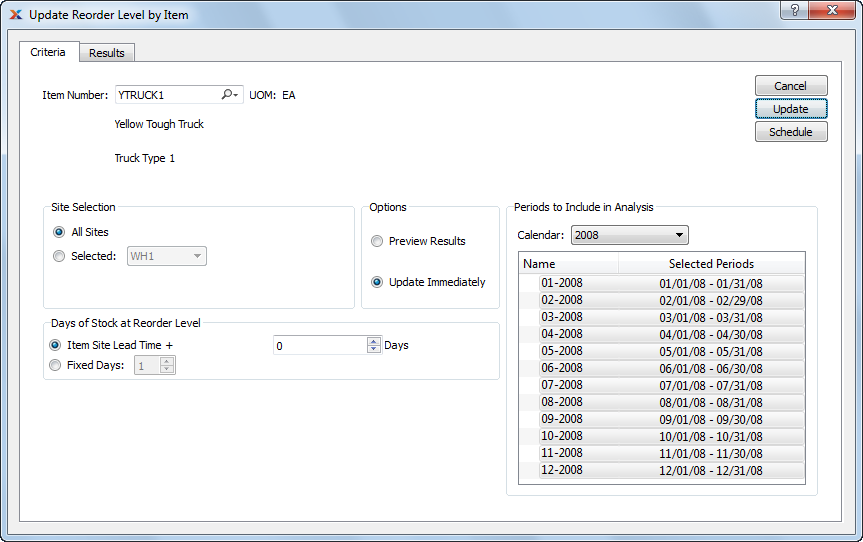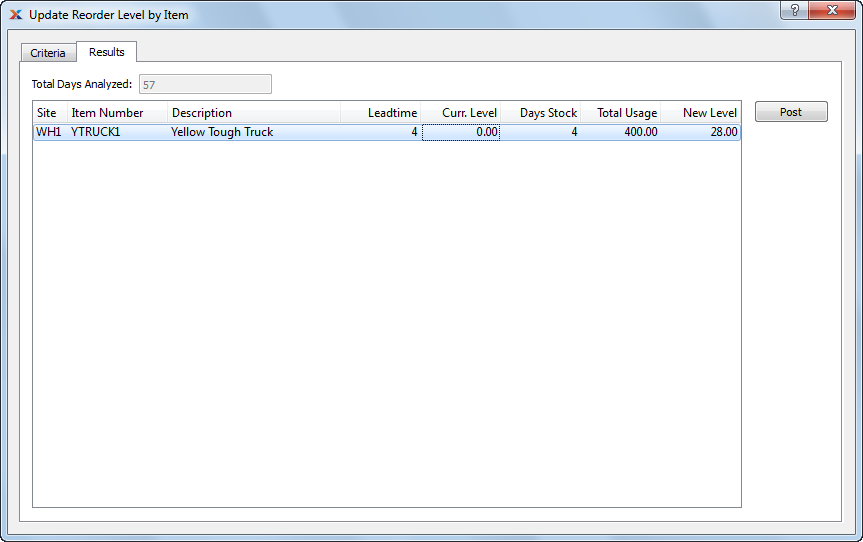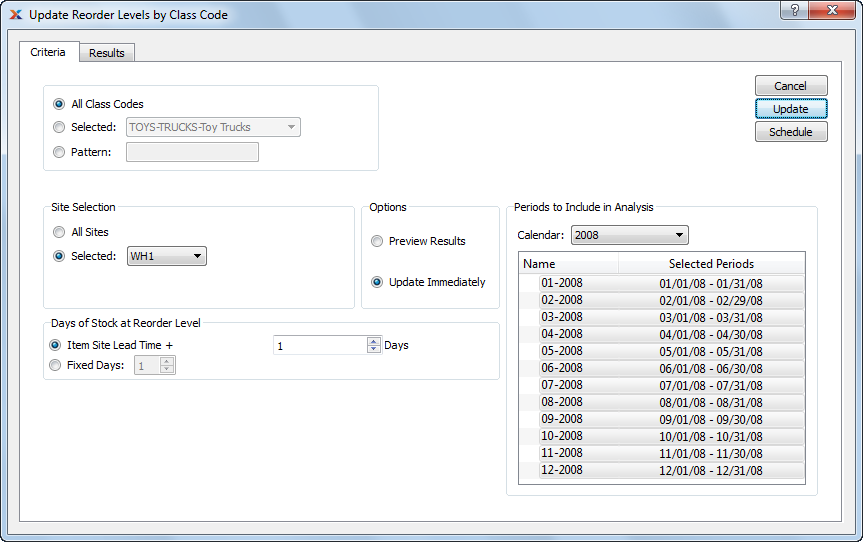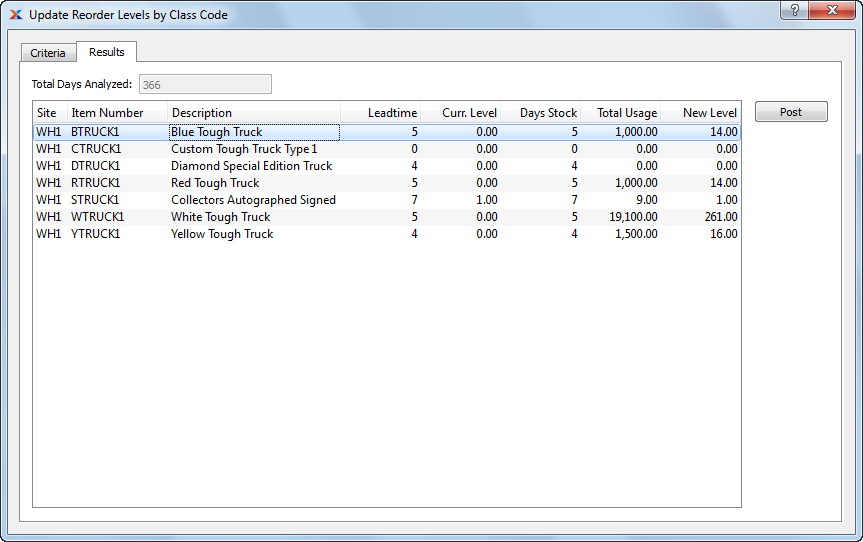
|
xTuple ERP Reference Guide |
To update reorder levels by item, go to . The following screen will appear:

This utility does not update reorder levels for items located in transit sites when it is run.
When updating reorder levels by item, you are presented with the following options:
Enter the item number of the item whose reorder level you want to update. The lookup feature located to the right of the field leads to a searchable list of make and buy items.
Inventory item description.
Inventory unit of measure (UOM).
Select what sites you want to query.
Select to update reorder levels by item for all sites.
Specify site where reorder levels by item are to be updated.
Select whether you would prefer to review results of analysis before updating reorder levels or update immediately.
Review results of analysis prior to updating reorder levels.
Update reorder levels without previewing analysis first.
Specify number of days using one of the following options:
Select a number using the arrows, or manually enter a value up to a maximum of 99. Average daily usage calculated using selected calendar periods will be multiplied by this value to determine reorder level.
Select a number using the arrows, or manually enter a value up to a maximum of 999. Average daily usage calculated using selected calendar periods will be multiplied by this value to determine reorder level.
Specify the periods to include in the analysis using the following calendar options:
Select the calendar you want to use for the analysis.
Select as many periods as you want to include in the analysis. Selected periods correspond to calendar specified in the Calendar field. Select individual periods or groups of periods together. To select an individual period, highlight the period using your mouse button. The period is now selected. To select a sequence of periods, highlight the first in the sequence using your mouse button. Then, holding down the key on your keyboard, highlight the last period in the sequence. The entire sequence is now selected. To select periods that are out of sequence (e.g., January, April, July, October), highlight the first period in the group. Then, holding down the key on your keyboard, highlight the next period you want to select. Continue highlighting periods with the key depressed until all desired periods are selected. The entire group is now selected.
To view results of query, select the tab. The following screen will appear:

Upon selecting results a list of analysis results will appear on the screen.
Shows how many days were analyzed in your analysis and also lists affected item sites.
Item sites subject to constraint management must always have a minimum reorder level of at least one. If your results indicate a new level of zero for one of these item sites, you will get an error message preventing the update. Item sites having the Stocked flag turned on are subject to constraint management.
To update reorder levels by planner code, go to . The following screen will appear:

This utility does not update reorder levels for items located in transit sites when it is run.
When updating reorder levels by planner code, you are presented with the following options:
Select to update reorder levels for all planner codes.
Specify planner code whose reorder levels you want to update.
Enter a planner code pattern to select a range of planner codes. Refine your search using regular expressions.
Select what sites you want to query.
Select to update reorder levels by planner code for all sites.
Specify site where reorder levels by planner code are to be updated.
Select whether you would prefer to review results of analysis before updating reorder levels or update immediately.
Review results of analysis prior to updating reorder levels.
The button will be disabled in this mode.
Update reorder levels without previewing analysis first.
Specify number of days using one of the following options:
Select a number using the arrows, or manually enter a value up to a maximum of 99. Average daily usage calculated using selected calendar periods will be multiplied by this value to determine reorder level.
Select a number using the arrows, or manually enter a value up to a maximum of 999. Average daily usage calculated using selected calendar periods will be multiplied by this value to determine reorder level.
Specify the periods to include in the analysis using the following calendar options:
Select the calendar you want to use for the analysis.
Select as many periods as you want to include in the analysis. Selected periods correspond to calendar specified in the Calendar field. Select individual periods or groups of periods together. To select an individual period, highlight the period using your mouse button. The period is now selected. To select a sequence of periods, highlight the first in the sequence using your mouse button. Then, holding down the key on your keyboard, highlight the last period in the sequence. The entire sequence is now selected. To select periods that are out of sequence (e.g., January, April, July, October), highlight the first period in the group. Then, holding down the key on your keyboard, highlight the next period you want to select. Continue highlighting periods with the key depressed until all desired periods are selected. The entire group is now selected.
The following buttons are unique to this screen:
The initial button converts to an button once results have been queried and the data is ready to be updated. Select this button to update reorder levels, using the specified criteria.
To view results of query, select the tab. The following screen will appear:

Upon selecting results a list of analysis results will appear on the screen.
Shows how many days were analyzed in your analysis and also lists affected item sites.
Item sites subject to constraint management must always have a minimum reorder level of at least one. If your results indicate a new level of zero for one of these item sites, you will get an error message preventing the update. Item sites having the Stocked flag turned on are subject to constraint management.
To update reorder levels by class code, go to . The following screen will appear:

This utility does not update reorder levels for items located in transit sites when it is run.
When updating reorder levels by class code, you are presented with the following options:
Select to update reorder levels for all class codes.
Specify class code whose reorder levels you want to update.
Enter a class code pattern to select a range of class codes. Refine your search using regular expressions.
Select what sites you want to query.
Select to update reorder levels by class code for all sites.
Specify site where reorder levels by class code are to be updated.
Select whether you would prefer to review results of analysis before updating reorder levels or update immediately.
Review results of analysis prior to updating reorder levels.
Update reorder levels without previewing analysis first.
Specify number of days using one of the following options:
Select a number using the arrows, or manually enter a value up to a maximum of 99. Average daily usage calculated using selected calendar periods will be multiplied by this value to determine reorder level.
Select a number using the arrows, or manually enter a value up to a maximum of 999. Average daily usage calculated using selected calendar periods will be multiplied by this value to determine reorder level.
Specify the periods to include in the analysis using the following calendar options:
Select the calendar you want to use for the analysis.
Select as many periods as you want to include in the analysis. Selected periods correspond to calendar specified in the Calendar field. Select individual periods or groups of periods together. To select an individual period, highlight the period using your mouse button. The period is now selected. To select a sequence of periods, highlight the first in the sequence using your mouse button. Then, holding down the key on your keyboard, highlight the last period in the sequence. The entire sequence is now selected. To select periods that are out of sequence (e.g., January, April, July, October), highlight the first period in the group. Then, holding down the key on your keyboard, highlight the next period you want to select. Continue highlighting periods with the key depressed until all desired periods are selected. The entire group is now selected.
The following buttons are unique to this screen:
The initial button converts to an button once results have been queried and the data is ready to be updated. Select this button to update reorder levels, using the specified criteria.
To view results of query, select the tab. The following screen will appear:

Upon selecting results a list of analysis results will appear on the screen.
Shows how many days were analyzed in your analysis and also lists affected item sites.
Item sites subject to constraint management must always have a minimum reorder level of at least one. If your results indicate a new level of zero for one of these item sites, you will get an error message preventing the update. Item sites having the Stocked flag turned on are subject to constraint management.